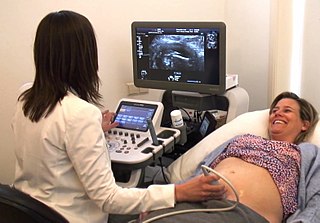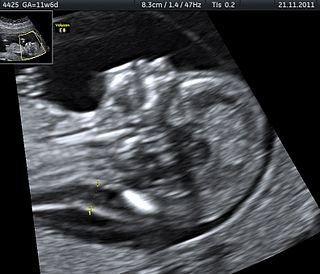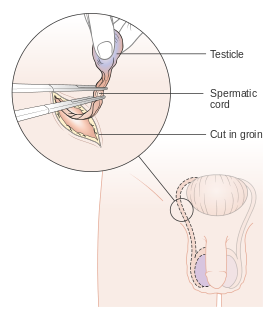
Midwifery is the health science and health profession that deals with pregnancy, childbirth, and the postpartum period, in addition to the sexual and reproductive health of women throughout their lives. In many countries, midwifery is a medical profession. A professional in midwifery is known as a midwife.
An omphalos is a religious stone artifact, or baetylus. In Ancient Greek, the word ὀμφᾰλός means "navel". Among the Ancient Greeks, it was a widespread belief that Delphi was the center of the world. According to the myths regarding the founding of the Delphic Oracle, Zeus, in his attempt to locate the center of the earth, launched two eagles from the two ends of the world, and the eagles, starting simultaneously and flying at equal speed, crossed their paths above the area of Delphi, and so was the place where Zeus placed the stone. Omphalos is also the name of the stone given to Cronus. In the ancient world of the Mediterranean, it was a powerful religious symbol. Omphalos Syndrome refers to the belief that a place of geopolitical power and currency is the most important place in the world.

The placenta is a temporary fetal organ that begins developing from the blastocyst shortly after implantation. It plays critical roles in facilitating nutrient, gas and waste exchange between the physically separate maternal and fetal circulations, and is an important endocrine organ producing hormones that regulate both maternal and fetal physiology during pregnancy. The placenta connects to the baby via the umbilical cord, and on the opposite aspect to the maternal uterus in a species dependent manner. In humans, a thin layer of maternal decidual (endometrial) tissue comes away with the placenta when it is expelled from the uterus following birth. Placentas are a defining characteristic of placental mammals, but are also found in marsupials and some non-mammals with varying levels of development.

A navel piercing is a type of piercing located through, in, or around, the navel. It may heal quickly and with no irritations, like an ear piercing, or may heal more like a surface piercing with the associated extended healing time. Healing usually takes around 6-9 months, or even more and as long as it is cleaned, it will heal nicely. Unlike most surface piercings, this is one of the few that do not normally reject, although the rejection rate is higher than non-surface piercings, such as ear piercing. The actual navel can only be pierced if it is an outie. For innies, the skin surrounding the navel is pierced at one or more locations. The most common form of navel piercing is through the upper rim of the navel. It is worn by many female celebrities including musicians such as Britney Spears, Janet Jackson, Beyoncé, Miley Cyrus, Avril Lavigne, Normani and Bhad Bhabie. Men also wear this type of piercing, an example being Slash, the guitarist of Guns N' Roses.

An appendectomy, also termed appendicectomy, is a surgical operation in which the vermiform appendix is removed. Appendectomy is normally performed as an urgent or emergency procedure to treat complicated acute appendicitis.

Stillbirth is typically defined as fetal death at or after 20 or 28 weeks of pregnancy, depending on the source. It results in a baby born without signs of life. A stillbirth can result in the feeling of guilt or grief in the mother. The term is in contrast to miscarriage, which is an early pregnancy loss, and live birth, where the baby is born alive, even if it dies shortly after.

The navel is a protruding, flat, or hollowed area on the abdomen at the attachment site of the umbilical cord. All placental mammals have a navel.

In placental mammals, the umbilical cord is a conduit between the developing embryo or fetus and the placenta. During prenatal development, the umbilical cord is physiologically and genetically part of the fetus and normally contains two arteries and one vein, buried within Wharton's jelly. The umbilical vein supplies the fetus with oxygenated, nutrient-rich blood from the placenta. Conversely, the fetal heart pumps low oxygen containing blood, nutrient-depleted blood through the umbilical arteries back to the placenta.
Maschalismos (μασχαλισμός) is the practice of physically rendering the dead incapable of rising or haunting the living in undead form. It comes from the Ancient Greek word and was also the term for procedural rules on such matters in later Greek customary law.

Lotus birth is the practice of leaving the umbilical cord uncut after childbirth so that the baby is left attached to the placenta until the cord naturally separates at the umbilicus. This usually occurs within 3–10 days after birth. The practice is performed mainly for spiritual purposes, including for the perceived spiritual connection between the placenta and the newborn.

Navel-gazing or omphaloskepsis is the contemplation of one's navel as an aid to meditation.
A self-performed caesarean section is a form of self-surgery where a woman attempts to perform a caesarean section on herself.
Omphalitis of newborn is the medical term for inflammation of the umbilical cord stump in the neonatal newborn period, most commonly attributed to a bacterial infection. Typically immediately after an infant is born, the umbilical cord is cut with a small remnant left behind. Normally the stump separates from the skin within 3–45 days after birth. A small amount of pus-like material is commonly seen at the base of the stump and can be controlled by keeping the stump open to air to dry. Certain bacteria can grow and infect the stump during this process and as a result significant redness and swelling may develop, and in some cases the infection can then spread through the umbilical vessels to the rest of the body. While currently an uncommon anatomical location for infection in the newborn in the United States, it has caused significant morbidity and mortality both historically and in areas where health care is less readily available. In general, when this type of infection is suspected or diagnosed, antibiotic treatment is given, and in cases of serious complications surgical management may be appropriate.

An umbilical hernia is a health condition where the abdominal wall behind the navel is damaged. It may cause the navel to bulge outwards—the bulge consisting of abdominal fat from the greater omentum or occasionally parts of the small intestine. The bulge can often be pressed back through the hole in the abdominal wall, and may "pop out" when coughing or otherwise acting to increase intra-abdominal pressure. Treatment is surgical, and surgery may be performed for cosmetic as well as health-related reasons.

In fashion, the midriff is the human abdomen. The midriff is exposed when wearing a crop top or some forms of swimwear. Cholis worn by Indian women expose a section of midriff, usually 4 to 5 inches.
Funisitis is inflammation of the connective tissue of the umbilical cord that occurs with chorioamnionitis. It involves only the external cord surface and Wharton's jelly. It has no involvement of the vessels. It does not involve the umbilical stump, which would be seen in omphalitis.

The Woman Who Had Two Navels is a 1961 novella by Nick Joaquin, a National Artist for Literature and leading English-language writer from the Philippines. It is considered a classic in Philippine literature. It was the recipient of the first Harry Stonehill award. It tells the story of a Filipino elite woman who is hallucinating, and is preoccupied with the notion that she has two navels or belly buttons in order to be treated as an extraordinary person.
Trans-umbilical breast augmentation (TUBA) is a type of breast augmentation in which breast implants are placed through an incision at the navel rather than the chest.

Orchiectomy is a surgical procedure in which one or both testicles are removed, as a form of castration. The surgery is typically performed as treatment for testicular cancer, in some cases of testicular torsion, as a gender-affirming procedure for trans women, and is sometimes used in the management of advanced prostate cancer.
Mummies 317a and 317b were the infant daughters of the Eighteenth Dynasty pharaoh Tutankhamun; their mother was likely his Great Royal Wife Ankhesenamun, who has been tentatively identified as the mummy KV21A. They were buried in their father's tomb, which was discovered by Howard Carter in 1922. The mummy referred to as 317a is of a girl who was born prematurely at 5–6 months gestation, and mummy 317b is that of a girl born at or near full-term. No names have been preserved for these children. These princesses represent the final generation of the Eighteenth Dynasty.













